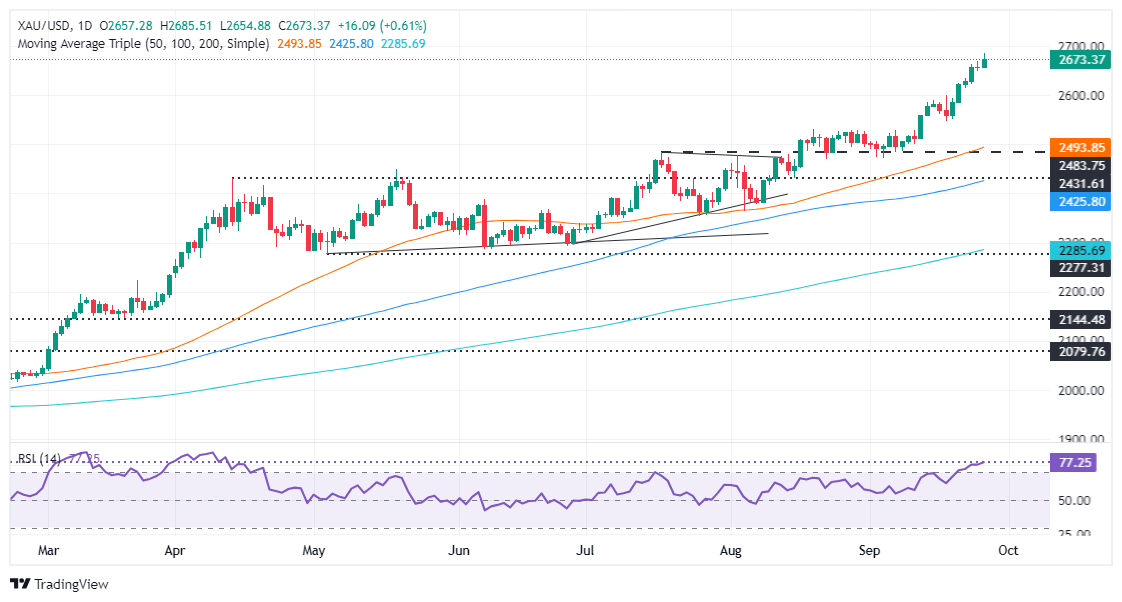- Gold hits all-time high of $2,685, boosted by Chinese stimulus and Middle East tensions.
- Despite the strength of the US Dollar, the Fed’s recent 50 bps rate cut fuels bullish sentiment for continued gains in Bullion.
- US economic data points to a ‘soft landing’ scenario, maintaining market optimism for further rise in Gold.
Gold hit a new all-time high of $2,685 on Thursday as the Dollar began to recover from earlier losses suffered in the Asian and European sessions. US data portrays a ‘soft landing’ scenario, while stimulus from China and rising tensions in the Middle East boosted Bullion prices. At the time of writing, XAU/USD is trading at $2,670.
Sentiment remains positive, as shown by US stocks. US Treasury yields remained firm, with the 10-year note yield at 3.798%, up one basis point (bps), while the Dollar, represented by the US Dollar Index ( DXY), remains flat at 100.91.
News from China supports the bullish move in Gold. The Politburo remains firm on stabilizing the real estate market, adding more fiscal stimulus after the People’s Bank of China (PBoC) reduced 7-day reverse repo rates by 20 bps, taking rates from 1.70% to 1.50%.
This and last week’s 50 bps rate cut by the Federal Reserve (Fed) pushed the gold metal to subsequent all-time highs as global central banks reduce borrowing costs. Even though the US Dollar remained strong, expectations that the Fed would initiate an ‘aggressive’ easing cycle kept bulls following the trend.
The US economy grew significantly in the second quarter of 2024, according to the Bureau of Economic Analysis (BEA). Meanwhile, the U.S. Department of Labor revealed that fewer people filed for unemployment benefits last week, a sign that the labor market remains strong.
Daily movements and market drivers: Gold price remains firm amid high US yields
- Missile attacks between Israel and Hezbollah support Gold prices.
- The US Gross Domestic Product (GDP) for the second quarter in its final reading was 3%, exceeding estimates of 2.9%.
- US durable goods orders in August were unchanged at 0%, beating forecasts for a -2.6% contraction, but fell short of July’s 9.8% increase.
- Initial jobless claims for the week ending September 21 were 218K, below estimates of an increase to 225K and the previous reading of 222K.
- According to the World Gold Council, physically backed Gold ETFs globally saw modest net inflows of 3 metric tons last week.
- Market participants have fully priced in at least a 25 bps rate cut from the Fed. However, according to the CME FedWatch tool, the odds of a 50 bps cut have dropped to 51.3%, from a 60 percent chance. % the day before.
XAU/USD Technical Outlook: Gold Price Advances Beyond $2,660
The price of Gold hit an all-time high of $2,685 on Thursday, but has fallen back to current spot prices. However, momentum favors buyers, although the recovery appears overextended, as shown by the Relative Strength Index (RSI) rising further into overbought territory, close to testing the extreme levels above 80.
If XAU/USD extends its recovery beyond the current yearly high (YTD) of $2,685, the next resistance would be the $2,700 mark. Next would be the $2,750 level, followed by $2,800.
On the other hand, if XAU/USD falls below $2,650, look for a test of the September 18 daily high at $2,600. The next key support levels to test will be the September 18 low of $2,546, followed by the 50-day SMA at $2,488.
Gold FAQs
Gold has played a fundamental role in human history, as it has been widely used as a store of value and medium of exchange. Today, apart from its brilliance and use for jewelry, the precious metal is considered a safe-haven asset, meaning it is considered a good investment in turbulent times. Gold is also considered a hedge against inflation and currency depreciation, since it does not depend on any specific issuer or government.
Central banks are the largest holders of Gold. In their aim to support their currencies in turbulent times, central banks tend to diversify their reserves and purchase Gold to improve the perception of strength of the economy and currency. High Gold reserves can be a source of confidence for the solvency of a country. Central banks added 1,136 tons of gold worth about $70 billion to their reserves in 2022, according to data from the World Gold Council. This is the largest annual purchase since records exist. Central banks in emerging economies such as China, India and Türkiye are rapidly increasing their gold reserves.
Gold has an inverse correlation with the US Dollar and US Treasuries, which are the main reserve and safe haven assets. When the Dollar depreciates, the price of Gold tends to rise, allowing investors and central banks to diversify their assets in turbulent times. Gold is also inversely correlated with risk assets. A rally in the stock market tends to weaken the price of Gold, while sell-offs in riskier markets tend to favor the precious metal.
The price of Gold can move due to a wide range of factors. Geopolitical instability or fear of a deep recession can cause the price of Gold to rise rapidly due to its status as a safe haven asset. As a non-yielding asset, the price of Gold tends to rise when interest rates fall, while rising money prices tend to weigh down the yellow metal. Still, most of the moves depend on how the US Dollar (USD) performs, as the asset is traded in dollars (XAU/USD). A strong Dollar tends to keep the price of Gold in check, while a weaker Dollar is likely to push up Gold prices.
Source: Fx Street
I am Joshua Winder, a senior-level journalist and editor at World Stock Market. I specialize in covering news related to the stock market and economic trends. With more than 8 years of experience in this field, I have become an expert in financial reporting.








